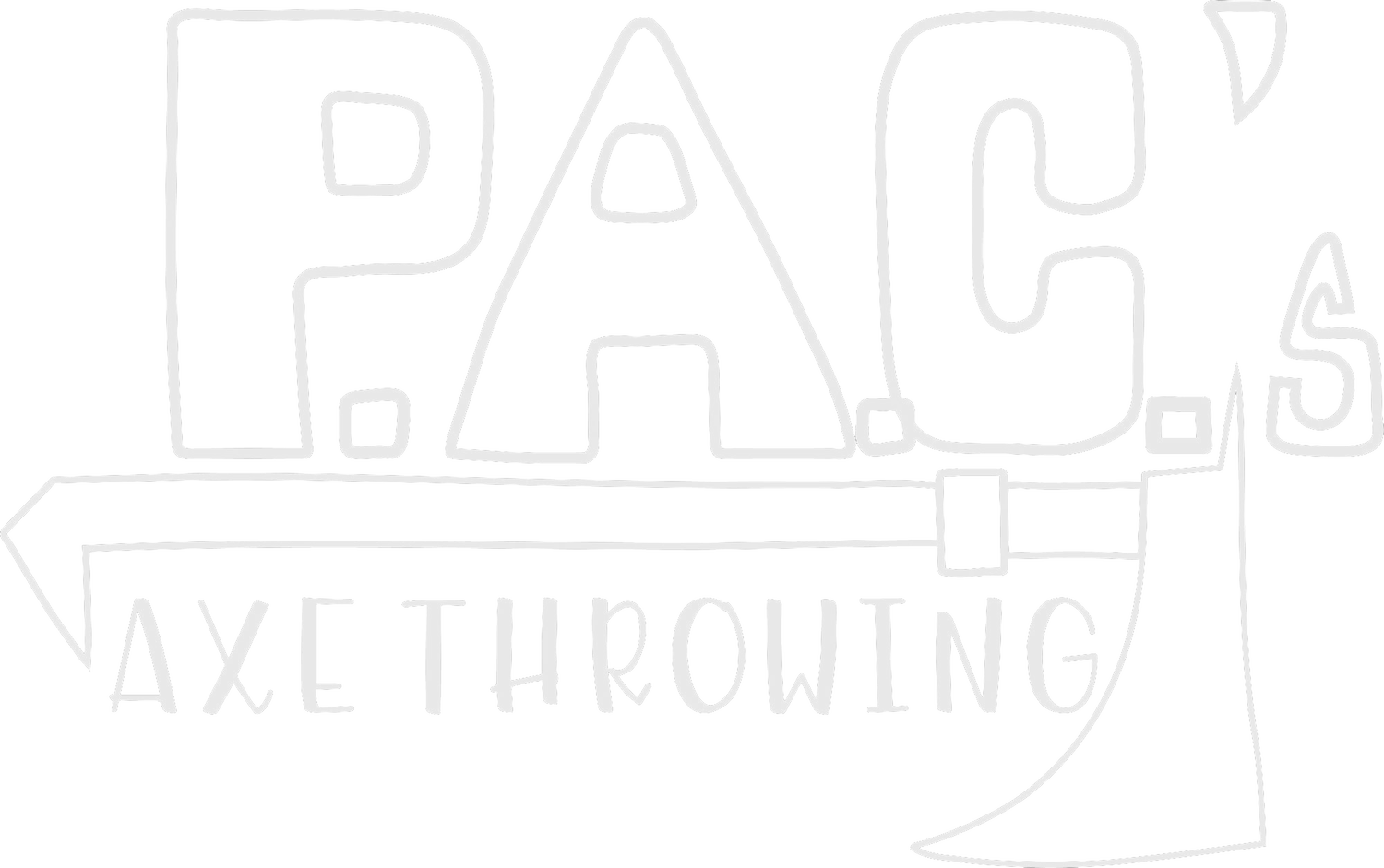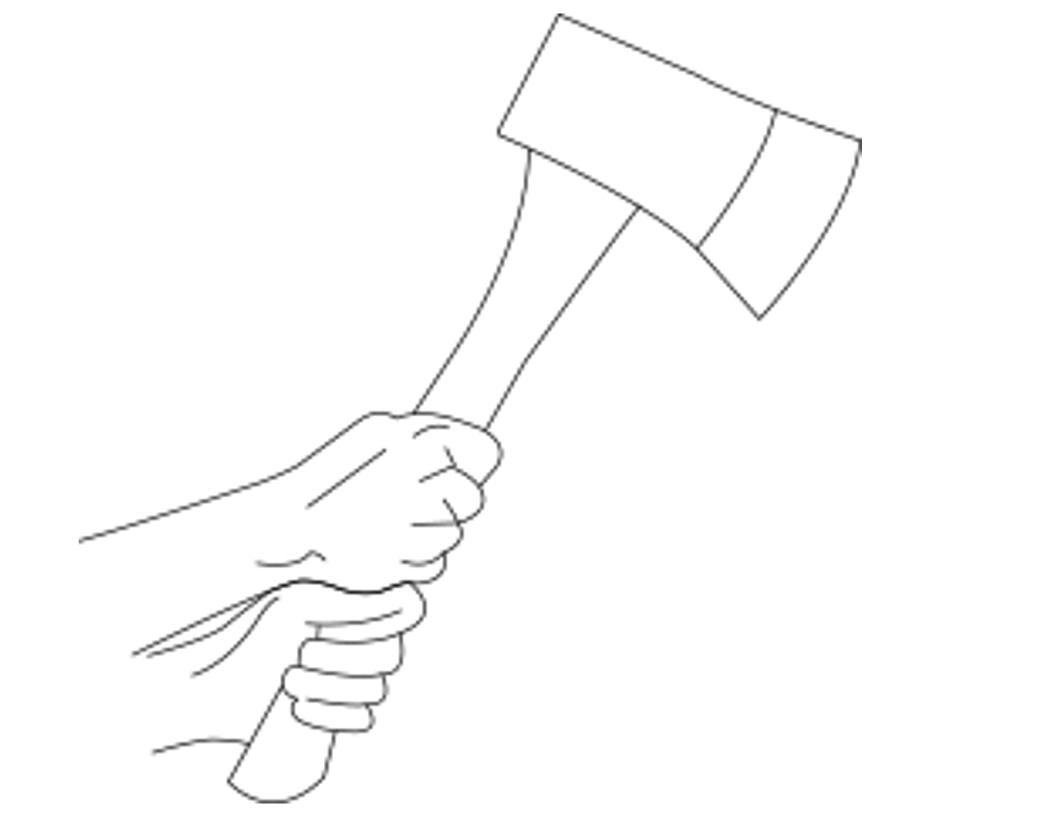Technicalities:
A Break (breaking) is defined as when the axe is embedded in the wood and has the marked surface of the target area visible on both sides of the valid scoring area of the axe head.
This concept is equally applied across all the target rings.
If the axe breaks multiple sections of the target simultaneously, then the player is awarded the points for the higher valued section.
Axes must be inside the black line in order to count for that value
Touching the black line will not give you the point value; the axe must be inside the higher scoring area to receive those points
For example: Touching the black line of the outer bullseye counts as a 4. Breaking it (unmarked wood of the outer bullseye on both sides) counts as a 5.
The Killshot must have a red outline using a ballpoint pen which will count as a scoring area, but any blue that bleeds outside of the red outline will not. To gain points for the Killshot, the axe must break red or blue if inside of the red outline.
The inner bullseye must have a black outline using a ballpoint pen which will count as a scoring area, but any red that bleeds outside of the black outline will not. To gain points for the inner bullseye, the axe must break red or black if inside of the black outline.
League Rules
Safety:
Axes
Each and every axe is inspected prior to each league night to ensure the axe is up to standard.
Broken axes may not be used.
Axe Heads must be one solid piece of metal held tightly to the handle
Axes Heads that have become loose or have an axe head that is easily removed (i.e., heads that are clamped or held into the handle by screw or pin) are dangerous and will not be considered for league/gameplay play
Participants are instructed to grip the axe by the handle and only the handle.
If an axe breaks or if a player would like to switch axes, they must notify the presiding official and are allowed up to 1 minute to switch axes.
Any throwers knowingly purchasing and throwing restricted axes will be subject to sanctions, including but not limited to: forfeiting tournaments, seasons and additional suspensions from P.a.C.’s based on the severity of the infraction
Injuries
If an injury occurs during league play and the player is deemed to be unable to finish the remaining matches by a judge or medical professional then they may make up their matches the following league night with no penalty.
This will not count towards the player’s right to miss 2 weeks
If there are throws remaining in the current match, then those scores are counted as zero
If an injury occurs during any tournament and the player is deemed unable to progress by a Judge or medical professional, then any matches pending will be marked 0 points scored and matches forfeit.
Throwing
Axes shall never be thrown when a participant is picking up an axe from the target area or when a judge is in the lane. This will result in an immediate disqualification (counted as a loss) for that match.
Pre-Game Rules:
1. Minimum Age:
P.a.C.’s enforces an age requirement of 12 years or older (accompanied by a parent or guardian for ages 12-15).
2. Target Quality:
Targets should be relatively new and of sound quality prior to league commencement.
When targets deteriorate to a point where excessive movement or ‘wiggling’ of the axes occur when they land in the damaged area causing or risking good throws to fall out, the boards should be switched out to ensure fair play.
Boards all must be individually secured and not able to slide or lift off from the target during Competition.
If a large piece of wood or chunk falls out during play, the player may request to have the board changed but the ultimate decision will fall on the axe throwing referee (judge).
Requests for board changes must be made before a game begins.
Requests for board changes cannot be made between games of a best 2/3 match set. The request must be made before the match begins.
Targets must be sprayed with water from a spray bottle prior to the start of league/gameplay.
If boards are continually hard, league/gameplay members may request to have more water sprayed on the boards.
No-one other than the official judge may alter the boards before, during, or after any match unless authorized by the presiding official.
This includes pulling out pieces of boards, chopping or softening the board with their axe, watering the boards, etc.
3. Warm Up Throws:
The number of warm-up throws allowed applies to all P.a.C.’s sanctioned leagues.
Players may have up to 1 hour of practice prior to match start time.
Players may have 1 practice throw prior to any match.
Players are not allowed additional practice in empty lanes between matches for any sanctioned events (league, tournaments, etc.) unless otherwise approved by a P.a.C.’s employed official.
A P.a.C.’s employed official may, at their sole discretion, determine a different amount of warm-up throws during any official P.a.C.’s event
The axe throwing referee will notify players when their match will commence.
The league will allow practice throws before official league start time subject to availability, fairness, and consent of referee on-premises.
Gameplay:
Each league week allows every participant 4 matches.
Each match is played against different opponents, selected at random and consists of the following:
10 throws per match.
In each match, players will take 5 throws then switch lanes with their opponent.
This ensures fair play when there’s varying density in wood.
The winner of the match will be the person with the most points after 10 throws.
In the event of a tie after 10 throws, there will be sudden death:
See Scoring below.
Starting targets will be determined by random selection.
All scores must be recorded by players and reported to league judge after each game conclusion.
After 7 weeks, the 8th and final week of each season will be the final matches to determine the season’s Local Champion.
Each official league run by an axe throwing venue is self-contained and may not be combined with other leagues.
Pauses in play
A presiding official may call a pause in play for any reason deemed necessary (rules review, confirmation, second opinion, etc.)
Should a Pause in Play occur, all match play must cease immediately and will resume at the discretion of the presiding official, where the pause began.
For Example: If one player has thrown but the opposite player has not and there is a Pause in Play called, the match will resume with the opposite player throwing as normal.
Players may be able to challenge a call or ruling which will create a pause in play
During this call, gameplay will be paused at that moment in time
Throwing in a Wheelchair
For individuals who use wheelchairs, all standard league rules apply with the exception of the foot fault line.
Individuals in wheelchairs must have one wheel behind the 12ft line when throwing in competition play.
Any wheel on the wheelchair is acceptable as long as one of them is behind the 12ft line.
Scoring:
Scoring Area of Axe
The axe head, blade and cheek up to the front of the eye but not past it.
An axe’s score is determined as the axe rests in the target and should not be removed to determine the score.
Please see exception for Duals throwing in Section P.
If there is no visible eye of the axe in the top of the axe head then it counts as where the handle would meet if going straight through. To be determined by the official presiding over the match.
Points
Axes must be inside the black line in order to count for that value:
6 points for the bullseye
5 points for the 1st ring (defined as the unmarked area between the bullseye and black ring around bullseye area)
4 points for the 2nd ring
3 points for the 3rd ring
2 points for the 4th ring.
1 point for the 5th ring.
8 points for the Killshot.
If the axe falls before the presiding official scores the axe, the axe is counted as a drop
Killshot Throw
The Killshots are active for the 5th and 10th throw during the 10-throw match.
Before throwing for the Killshot, the player must make clear to the Judge and opponent they intend on throwing for the Killshot.
The call must be made to the Judge before either opponent throws.
A judge should remind throwers on which killshot they threw on if the killshot is hit during previous attempt(s), so the throwers know which killshot is open
It is also recommended that players confirm with the Judge, what killshot is open for subsequent throws when a previous killshot is hit
This is referred to as “calling the Killshot” and activates it for the full 8 points.
The player cannot change their call (Killshot or non-Killshot) once a Judge confirms, for that specific throw.
Players are allowed 2 Killshot attempts per match
Once a player hits a Killshot during the match, that Killshot cannot be attempted again until the opposite one is hit.
If a Killshot is attempted but missed, the player may throw for that Killshot again.
Does not apply to overtime (OT) throws. Killshots are reopened in OT play.
Players may start their OT throws utilizing either Killshot, but must continue to alternate Killshots on subsequent OT throws.
In the event of a stalemate caused by throwers refusing to call the Killshot first, this will be solved by a coin toss.
The winner of the coin toss will choose who will call first.
In the event of a drop during any standard or Killshot throw, the player may opt to take a 3rd additional Killshot attempt during the regular 10 throw match.
A drop must be correctly recorded and the match to allow a 3rd Killshot attempt.
Example: If a player has taken their 2 Killshot attempts and a drop occurs on the 9th throw, they are eligible for a third Killshot attempt on the 10th throw.
Example 2: If a player has a drop on their 10th throw, they are not eligible for an additional Killshot attempt or throw.
Previously stated rules regarding alternating Killshot throws will still apply
If the player does not indicate that they are making a Killshot attempt, the Judge will assume it will be a standard throw (a non-Killshot attempt)
If a Killshot attempt is made prior to a Judge confirming the Killshot call, the throw will be counted as a fault
If the Killshot is called but the player’s axe does not hit the Killshot, then no points are awarded.
Sudden Death
In the event of a tie after 10 throws in a single match, the match enters into sudden death.
Points are not counted or tallied during sudden death.
Hatchet Sudden Death
ONLY Killshots are active during sudden death throws.
Players will remain at their respective targets for sudden death throws (no switching of targets required).
Players must alternate Killshots.
Once the Judge confirms that the lane is open both players must throw within 10 seconds of each other.
In the event that both players miss the Killshot during Sudden Death, a measuring tape or accurate measuring device, will be used to measure the distance from the closest valid scoring area of the axe head to the closest edge of the Killshot.
The player with the shortest distance will be awarded the match.
If Player 1 has an axe that has dropped and Player 2 misses the Killshot, but is on the board, Player 2 will be awarded the match.
If a player touches their axe before a measurement is made, the match is awarded to the opposing player.
Axe Throwing:
Axe Throwing Technique:
P.a.C.’s players are allowed to throw axes in one of two ways:
1 Hand holding the axe, in an overhand position, with the blade facing the target before release.
2 Hands holding the axe with the blade facing the target before release.
No other style of throws are permitted.
No throw will be thrown without a verbal or gesture signal of an Open Lane from the presiding judge and confirmed by all throwers.
If no signal is given or confirmation received, and a throw is made by a thrower, then that throw will count as a throw fault.
Throws must be taken within 10 seconds of each other.
If a thrower throws after 10 seconds of the other thrower, this will result in a Throw Fault.
Rotation: the axe must make approximately 1 rotation in order for it to count.
If the axe is close to making a full rotation (i.e., 50% rotation) and a portion of the blade touches and sticks to the target, the throw counts.
Axe Throwing Distance:
One foot must be on the floor while the axe is thrown.
Player’s feet may not cross the 12ft line until both axes have been verbally scored by the judge. Crossing the 12ft line before the judge scores both axes will result in a foot fault and the player’s throw will be scored a zero.
If a player calls for a second opinion, both players must return behind the 12ft line until the second judge calls the score.
If a player touches their axe before a second opinion call is made, the original score given by the first judge stands.
An exception is made for throwers in wheelchairs.
All Non-throwing Spectators must be to the side or at least 3ft behind throwers.
Attendance:
Late Players and/or Early Departures:
Players are allowed to arrive up to 30 minutes late, after official league start time.
Players may leave early if necessary.
Absences:
Players are allowed to miss up to 2 days of regulation play during the season and make up their matches and throws in subsequent weeks:
Players must make up any missed matches by week 9, otherwise, a loss will be attributed to their absence with a score of 0. If a player knows they’ll miss week 9 they must pre-throw any missed matches (up to 10 total for the season) before week 9 takes place.
No missed matches and throws are to be performed during week 10 – the 9 week mark is the cut off.
In order to miss a regulation league night, players are required to give a minimum 1-day notice to the referee of their absence.
League participants are able throw up to 2 weeks in advance, including weeks 8 and 9, in anticipation of an absence
This will count towards the participants ability to miss up-to 2 weeks of league play
If a League participant misses 3 weeks or more of league play, and does not make up those weeks, they cannot participate in week 10.
Misconduct:
Purposeful Distractions are defined as, but not limited to: Excessive celebration, taunting, using abusive, threatening or insulting language, trash talking, stepping in the lane during a throw, excessive noises, offensive gestures to opponents or any purposeful distractions with the intent to distract a player during a league match or tournament round will not be permitted during games.
First Offense:
The first purposeful distraction from an opposing player will result in a zero score for that throw, for player causing the distraction
The first purposeful distraction from a spectating league member or tournament participant will result in a zero in their first throw of their next match
The first purposeful distraction from a spectator not participating in league or tournament will result in the immediate removal from the facility
If the first purposeful distraction is a gross violation, intended to either save the player from a loss, intimidate the opposing player, or be an act of aggression against the opposing player or Judge, P.a.C.’s or the presiding Judge may elect, at their sole discretion, that the player causing the purposeful distraction to be removed from the tournament, league and/or facility.
Second Offense:
The second purposeful distraction from an opposing player will result in a forfeit for that match. Zero scores will be entered for the full match.
The second purposeful distraction from a spectating league member or tournament participant will result in a forfeit from their subsequent match. Zero scores will be entered for the full match.
Third Offense:
The third purposeful distraction from an opposing player will result in a forfeit of the season for league play or forfeit from the tournament. The player will not be allowed to throw for the remainder of the season or remainder of tournament.
The third purposeful distraction from a spectating league member will result in a forfeit of the season or tournament. The league member or tournament participant will not be allowed to spectate or participate for the remainder of the season or tournament.
Match Fixing & Hippodroming in League Play or Tournaments:
If any player is found to fix a match to achieve a desired outcome, during league play or tournaments, then that player will be banned from all P.a.C.’s tournaments & league. Player may appeal the ban, one year after the offense, pending review of the Owners.
Not completing tournament or event requirements for participation.
Anyone not completing pre-established tournament requirements (such as qualifying throws) will result in their position in the event/tournament being forfeit.






